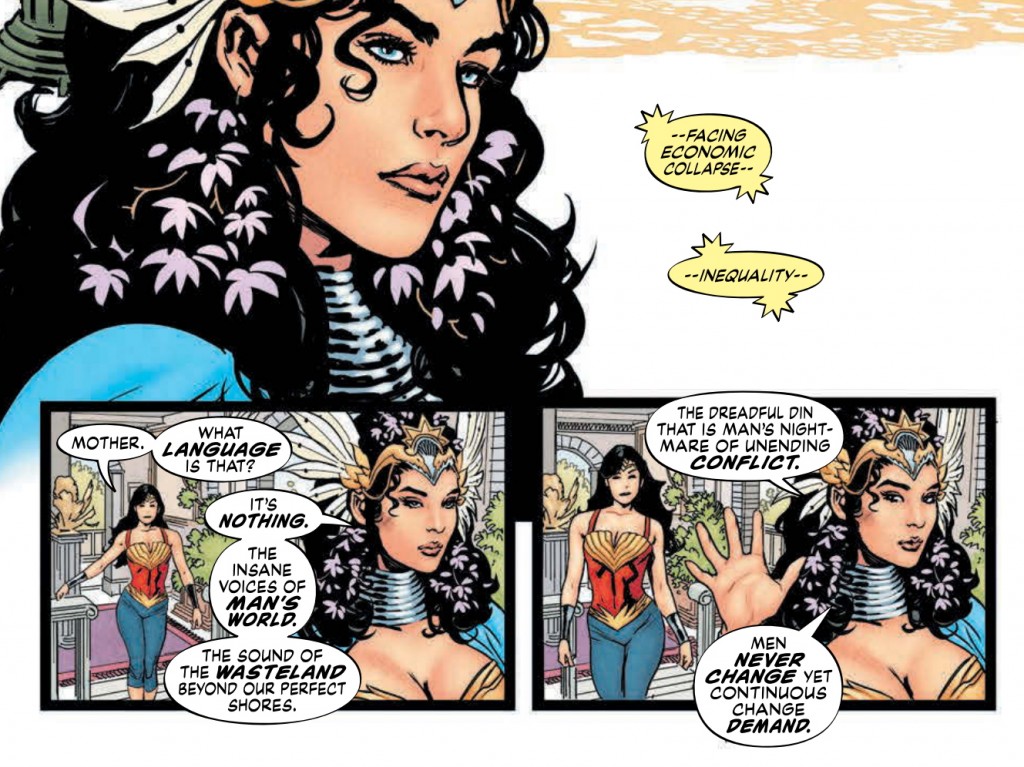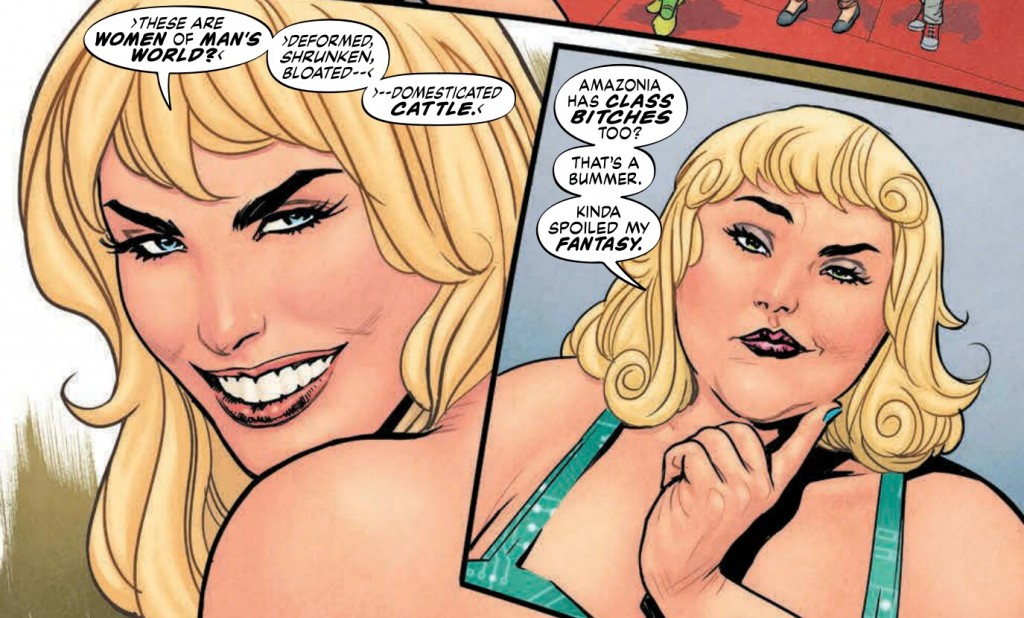Long gestating Grant Morrison projects develop this thick shade of moss around them in the years waiting for their release. Every new interview or sound bite or offhand comment leads to whirlpools of salivation, providing his die hard fans with enough catnip to work themselves up to a froth. By the time the finished product hits the shelves, we’ve already spent countless nights picking apart his theoretical suppositions, and the book itself has a high bar to clear to feel successful. His failed WildCATS relaunch with Jim Lee comes to mind. From his original proposal:
“First off, having heard the phrase for decades, I really started getting into the idea of ‘adult superheroes’ and what that might really mean. Superhero comics are often described as ‘adolescent power fantasies,’ so I began to wonder what an ‘adult power fantasy’ comic would be like.”
Now, if you’ve read the one issue that actually came out, you’ll know that very little of the finished title was able to rise to the occasion of such a tantalizing premise. Seriously, re-read it. At one point Spartan straight up quotes this idea within the text of the actual comic. Outside of some choice Grifter moments, it’s an absolute shit show. Luckily for us, Morrison comes a lot closer to making good on his ambitious ideas with Wonder Woman: Earth One, his latest collaboration with Yanick Paquette (and colorist extraordinaire Nathan Fairbairn).
If you’ve never read any of DC’s other Earth One graphic novels, continue doing yourself the favor of keeping it that way. They’re conceived as being entry points into iconic characters for newer fans who don’t want to get bogged down in heavy continuity. A gateway drug for the kind of people who don’t regularly see “Crisis” in the titles of their reading materials. J. Michael Straczynski used the the line to further explore his take on Superman, which, if we’re being honest, amounted to little more than a really cynical rip-off of J.J. Abrams’ Last Son of Krypton screenplay. Geoff Johns and Gary Frank delivered two volumes of a Batman reimagining that makes the Snyderverse seem downright whimsical. In company like that, Morrison’s goal to tell the ultimate Wonder Woman story seemed like an easy heist to pull.
The narrative is more digestible than the last few comics Morrison has put the pen to, but still possessing a depth beyond this publishing line’s standard, weaving a non-linear tale around “The Trial of Diana” for treason against Themyscira.
The book opens with a flashback to Hippolyta’s time under the heel of the darkest timeline’s Hercules, a frightening origin for the Amazons. This is scary rapist Mel Gibson in a lion’s pelt Hercules we’re talking about, and he’s presented as a comically overt villain, not unlike the Fox News Lex Luthor that Morrison pitted against Calvin Ellis Superman. It’d be funny how blatantly terrible he is if it wasn’t so real. Once Hippolyta gets her revenge and Hercules and his men are defeated, we’re treated to the greatest jump cut in comic history (“3000 Years Later”) where everything is fucking lit.
This take on Themyscira could best be described as the best Beyoncé video ever if it wasn’t painted so broadly with white flesh, but it’s a depiction of paradise that exalts femininity to the point of near parody. Morrison’s vision of a world free from toxic masculinity but full of jet packs, art, and philosophy is a welcome change of pace from the stock Xena: Warrior Princess diorama most Wonder Woman comics are satisfied with, but there’s something about its depiction that feels false. You can’t shake the sense that two largely straight white dudes are trying to present a progressive utopia for disingenuous reasons. This part of the book reads like a late night Tumblr shitpost come to life, and much of that disparity is on the visual side.
Paquette’s art becomes a way for Morrison to have his cake and eat it, too. It’s an interpretation heavily influenced by the original William Moulton Marston comics, where Morrison wants to explore sexuality very differently from comics that otherwise seem drawn with actual penises instead of pencils. The pin-up influence is on display and the sensual line work suggests curvaceousness without having Frank Cho or whoever on board to make this a cheap stroke book for frustrated teens. The problem is that Paquette isn’t that far removed from “good girl” artists like Adam Hughes. Here, he experiments along the lines he started back on Batman, Inc., only with very deliberate flourishes in the off kilter layouts. If he aped J.H. Williams III less, you’d spend fewer pages of the book wishing he was here instead.
If you set aside that oddness in having a deliberately definitive take on such an iconic female character being conceived by dudes, there’s a lot to like in this book.
 Mainly, the relationship between Diana and Hippolyta presents a more dramatically satisfying spin on her usual origin story. Instead of a man crash landing setting up a weird romance, Diana is raging against her mother’s influence. Themyscira may be a paradise, but it’s one they’ve all lived in for three thousand years. It recontextualizes her exodus as the story of a girl who needs to leave home to challenge herself. Steve Trevor still shows up, but he’s not the blonde haired, blue eyed phallus rocking the Amazonian world with his mere presence. He’s black and presented as an interesting supporting character rather than a forced love interest.
Mainly, the relationship between Diana and Hippolyta presents a more dramatically satisfying spin on her usual origin story. Instead of a man crash landing setting up a weird romance, Diana is raging against her mother’s influence. Themyscira may be a paradise, but it’s one they’ve all lived in for three thousand years. It recontextualizes her exodus as the story of a girl who needs to leave home to challenge herself. Steve Trevor still shows up, but he’s not the blonde haired, blue eyed phallus rocking the Amazonian world with his mere presence. He’s black and presented as an interesting supporting character rather than a forced love interest.
There’s a moment with a leather collar that has already ruffled some feathers, but outside of that dubious sequence, Morrison’s new version of Trevor fits this story so much better. It teases cape comic intersectionality by focusing on his blackness to display shades of masculinity and oppression in a way far less heavy handed than I would have expected in a book that opens with the line “To heel, bitch of Hercules!”
The real star of the show is Etta Candy, who Morrison and Paquette recast as Pam from Archer, giving her an irreverent tongue and a lot of quotable dialogue. At first, she seems little more than fat girl comic relief, which would have been a shame, but as the narrative progresses, she becomes the only character capable of saliently criticizing the Amazons. It’s a delicate balancing act, as Morrison puts so much work into lionizing their isolationist progress, that cutting them down in the interest of the story can’t undo the aspirational imagery he loves so much.
All told, Wonder Woman: Earth One is a brisk, entertaining read with some palatable art and a few bright spots of merit, but it still comes up short in delivering the promise of a Grant Morrison Wonder Woman book. It follows in the footsteps of a male writer retconning Diana’s origin to make it better fit their perspective, much the way Brian Azzarello did, albeit with a different paternal path. It seems Wonder Woman, like Superman, continues to be an icon misinterpreted by creative teams more often than not. If you’re looking for the definitive take on the mythology, this might not be it, but it comes close. Fun for Morrison completists, but potentially a bore for anyone tired of male writers contorting female stories to match their creative needs.




